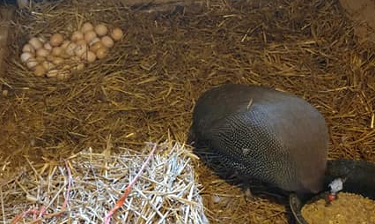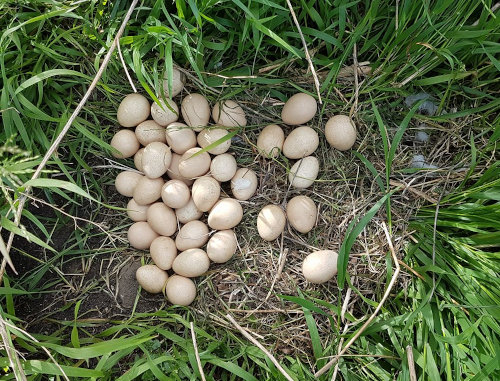Guinea fowl nests and nesting boxes.

Guinea fowl kept with other poultry will usually, but not always adapt to some extent to the system already in place.
Guineas also seem to much prefer sand to nest on rather than hay or straw and will often scrape out quite a deep hole to get down to the earth.
Do Guinea fowl need nesting boxes?
Guinea fowl do not need nesting boxes but they do need a heap of sand to use as a nest. Guineas don't nest in the same way as chickens do and prefer to nest in a secluded, dry and sandy spot.
You can provide your Guineas with nesting boxes and those birds that are kept with chickens or were raised by chickens will probably use them.
Below: This huge clutch of Guinea fowl eggs was hidden in a hay trough.

I have Guinea fowl that use nest boxes and some that don't so your mileage may vary. Mine were raised by chickens and tend to follow the hens examples.
Guinea fowl nesting behaviour:
Guineas prefer to nest as they would in the wild, in a shallow depression in a secluded place with lots of cover. The nest is often communal and a male usually stands guard.
Below: A Guinea hen with her nest.

This is a few of the characteristics of the laying guinea hen:
- Guinea fowl prefer to nest outdoors in natural surroundings.
- Outdoor nesting sites are a shallow depression in the ground and well hidden in hedgerows or amongst nettles or tall grasses.
- Egg laying in Guinea fowl may begin as early as the end of February in the Northern Hemisphere but usually from March through to September or early October.
- Guinea hens can lay an egg a day and will usually lay in four clusters of 20 to 30 eggs with a break in between.
- The hen may start egg laying from 24 weeks of age depending on the time of year they were hatched.
- They are seasonal layers and mine do not lay at all in Winter.
- Guinea fowl rarely if ever use a nest box if they have a choice, but those raised by chickens may do.
- Keeping Guinea fowl in the run until after lunch may force the Guinea hens to lay eggs indoors.
- If they see you take the eggs they will move the nest.
- An empty nest will be abandoned so always leave at lest one egg in the nest.
- The nests are extremely hard to find.
Do Guinea fowl bury or hide their eggs?
Guinea fowl are expert egg and nest hiders but they do not bury their eggs in the sand.
If a Guinea sees you taking eggs form her nest she will not return to it and will look for another spot, they absolutely hate having their nests disturbed in any way.
Below: A well hidden Guinea nest but the eggs are on the surface.

I was always finding secret Guinea fowl nests in some very unusual places, I once found nearly 60 eggs in a communal nest underneath my shed. I was convinced that the Guineas wouldn't fit in such a small space but I was wrong.
What does a Guinea fowl nest look like?
Guinea fowl nests are a shallow dip in the ground lined with grasses or straw but sometimes nothing.
They do not need a box and generally steadfastly refuse to use them, preferring to be able to look around them.
Guinea hens will often share nests, which explains finding the addition of 2 or more eggs to a nest in a day. I have discovered a with 50 or more eggs in. The trouble is a predator will generally find it before you do and eat the eggs and make a mess of the rest.
How do you find a Guinea fowl nest?
Start by searching along the fence rows and in high grasses or well covered patches of scrub land. Look around fallen trees and behind garden sheds or outbuildings.
If you keep males her mate might be seen guarding her during the day but will usually go home to roost at night when she needs his protection the most. You might get to her by following him in the mornings.
In log piles or among the branches of fallen trees is another Guinea favourite. Or under sheds, you will be surprised where they manage to squeeze.
Can you make Guineas lay in the nests?
To some extent, yes. Guineas raised by hens tend to roost and lay as chickens would, mine lay on the hen house floor rather than in the nest boxes but they do go in the shed to do it.
Keeping them shut in is the other way, let them out of the coop and run only after lunch when they are likely to have laid eggs already.
Always have pottery eggs in the nest you want Guineas to use and never let them see you taking their eggs.
